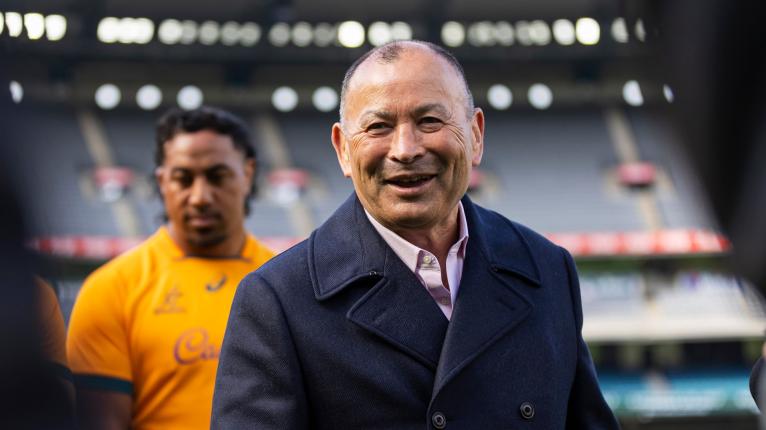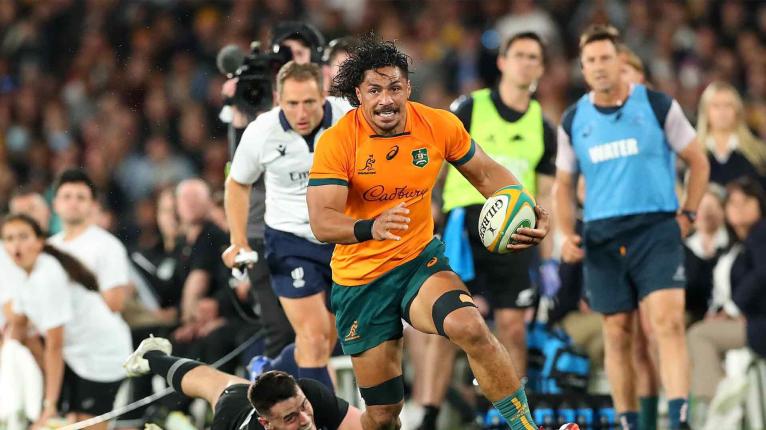Who can unravel the unfathomable quandary of Australian rugby? Who even wants to take on the challenge? The double-edged lot has now fallen to Eddie Jones, who coached the Wallabies as long ago as 2001, two decades distant.
Judging by recent comments he made in conversation with ex-England skipper Lawrence Dallaglio for The Evening Standard podcast in the UK, even Eddie might not be up for it for long
“I’m only coaching until this World Cup,” he said.
“I’ve signed [until the end of 2027], but as I’ve made the mistake before, I’ve stayed too long. So, [if] we win the World Cup, it will be time to go. If we lose the World Cup, it will be time to go.”
A few days later, Jones sensibly balanced the ledger in a statement to the local press: “I am here for five years. But my only concentration is this Rugby World Cup, so I don’t think past that.”

Despite the reassurances, such changes of mental tack will have supporters of the green-and-gold squirming uncomfortably in their chairs. The shifting sands of Eddie’s thinking accurately reflect the Jekyll-and-Hyde nature of the game in Australia. It draws the extremes of reaction because of its own maddening inconsistencies.
It produces as much natural athletic talent, if not more, than any country in the world, but much of the rugby-friendly potential is siphoned off to league and Aussie Rules before it ever reaches maturity. Rugby Australia then has to buy that talent back at an outrageous premium later in its lifetime.
It obstinately clings to a five-team structure in Super Rugby with little or no evidence it can compete with New Zealand on those terms, and without an organic local competition like the NPC to give it a solid footing at the level below.
Professional inconsistency permeates all the way through to the top of the game. On their November tour, the Wallabies came within an ace of beating France, losing on the last play of the game, and held world number one Ireland to a trifling three-point margin of victory in Dublin. At the same time, they lost to Italy mid-tour and had to come back from the dead to beat their fellow Six Nations’ cellar-dwellers Wales in the final round of matches.
Australia was 34-13 down after 52 minutes, but a purple patch of scoring turned the odds on the casino. Dismal defeat transformed into a stirring comeback win by 39 points to 34, and that is typical of the stream of volte-faces that characterise Australian rugby.
Inconsistency of performance has a handy statistical short-hand, in the form of ball-in-play time. Teams who can handle high ball-in-play time successfully, and enjoy the lion’s share of it, tend to win more often than they lose. It is as simple as that.
At the Bledisloe Cup series in September, outside half Bernard Foley only had to boot the ball off the field in order to secure a win against the All Blacks at the Docklands Stadium in Melbourne. Foley dithered, French referee Matthieu Raynal lost patience, pulling the pivot up for a ‘delay-of-game’ turnover scrum; New Zealand scored and won the game at the death.
The Wallabies were ritually buried only seven days later by the Kiwis at their Eden Park graveyard, 40 points to 14. Only a handful of sod on the coffin was missing. You could be forgiven for believing that in rugby terms at least, Australia is its own worst enemy.
It was no different in the final round of regular season Super Rugby Pacific matches last weekend, with two aspirational Aussie qualifiers for the knockout stages, the Queensland Reds and the New South Wales Waratahs, going down heavily to the Fijian Drua and Moana Pasifika respectively. Neither side was able to build any momentum for two difficult away games ahead in New Zealand to come. The Reds were drubbed 41-17 by the Drua in Suva, and the Tahs lost to Moana in Sydney, 33 points to 24.
Inconsistency of performance has a handy statistical short-hand, in the form of ball-in-play time. Teams who can handle high ball-in-play time successfully, and enjoy the lion’s share of it, tend to win more often than they lose. It is as simple as that:
- The average ball-in-play time for regular season SRP 2023 was 35.0 minutes. Games involving New Zealand teams averaged above that – 35.9 minutes of ball-in-play with 18.3 minutes of active possession for the Kiwi sides. Matches for Aussie sides fell below the mean – 34.8’, and 17.1’ respectively.
- The five teams with winning records in the competition (the Chiefs, Crusaders, Blues, Brumbies and Hurricanes) averaged even higher – 36.0 minutes of ball-in-play with 18.3’ of active possession time.
- The averages for the top four teams in New Zealand were another step up – 36.2’ of ball-in-play with 18.7 minutes of time-in-possession.

It was the same story in the 2022 Rugby Championship, with the All Blacks topping the charts with 32.1 minutes of ball-in-play and 16.9 minutes of active-possession time, and Australia dead last with 30.5’, and 15.1’ respectively. It is a simple equation. If you do not know how to keep hold of the ball, or work out ways to get it back quickly when you lose it or kick it away, it makes games of professional rugby much harder to win.
The Fijian Drua and Moana Pasifika occupy the bottom two positions in the table for both of those two stats, but they still managed to dominate their Australian opponents in the last round of the regular season. They enjoyed more carries and forced their opponents to make the majority of tackles, jointly making nine more line-breaks and conceding four fewer penalties than their more illustrious rivals from New South Wales and Queensland.
Ball-in-play time is linked to a team’s ability to secure first-phase possession, skill with ball in hand after it’s won, and discipline in contact on attack and in defence. If you are used to high ball-in-play, you are more likely to be able to sustain a consistent effort in all three areas.
In the game at Allianz Stadium in Sydney between the Waratahs and Moana Pasifika, the home side failed all three tests. They failed to secure their own first-phase lineout ball, losing six of their own throws. They didn’t keep it after they won it, and they didn’t work hard enough off the ball after making a tackle.
There were red flags aplenty even in the first quarter of the game, which suggested that the home side was either not expecting, or not used to sustaining consistent effort on defence:
It’s only the third phase from a Moana attacking lineout, but not one NSW forward has made it around the corner of the ruck. If the forwards don’t work hard on the interior, the defence cannot shuffle further out. Lack of work off the ball commits the backs on the outside to ‘soaking’ in contact, and they cannot prevent their powerful opponents making easy yardage into the home 22.
The Waratahs were penalised at the ensuing ruck, and Moana Pasifika scored from the next close-range lineout via their blockbuster left wing Timoci Tavatavanawai.
Lineout defence is often the premium litmus test of defensive application. In the following example, it broke down very quickly indeed:

The lineout starts with six backs apiece in the eagle’s eye view. Even after a dominant hit at the first tackle by their skipper Michael Hooper, the Waratah forwards are slower around the corner off the first ruck than their Moana opposites:

Moana No 6 Miracle Fai’ilagi is quicker in support of the ball than any of the NSW forwards, and that creates the extra man for the break. It is all far too easy.
A similar example in the second half was converted for the full seven-pointer:
Moana win an un-useful ball from the front of the lineout, and the Waratahs miss a first upfield tackle which would have stopped attacking progress in its tracks, but it is the lack of awareness and urgency at the first breakdown which is truly surprising.
Only one sky-blue forward, No 19 Charlie Gamble, makes it around the corner of the first ruck. That gives their opponents easy access to the width of the field on the open side on the second phase, and Christian Leali’ifano runs away to convert a magnificent score.
It was a depressingly recurrent theme for the home side:
Not one Waratah forward wraps around the corner to the far side of the ruck, and there is a huge gap between the first forward (prop Nephi Leatigaga) and the first back (midfielder Mosese Tiupulotu), ripe for exploitation by Tavatavanawai.
The same lack of urgency in transferring personnel from one side of the ruck to the other cost New South Wales dearly in its own red zone:

There are no less than six Waratah forwards stuck within three metres of the ruck perimeter, and that creates easy pickings for backs as powerful as Moana’s further out.
Eddie Jones may have had tongue partly in cheek when he jokingly insinuated that he might flee the Wallabies coop after the World Cup in September, but his comments underlined the serious inconsistency of rugby in the country, and the size of the task confronting the Randwick man after his 20-year sabbatical.
Nobody can predict how any Australian sides (except maybe the Brumbies, but even they have faltered late in the season) will play from one week to the next, and that is a huge problem for coaches, whose livelihood depends on establishing consistent, repeatable standards of performance.
The stats for ball-in-play time provide a statistical entry point to that inconsistency. The recent URC final between the Stormers and Munster had over 42 minutes of the precious stuff, and was remarkable for its sustained intensity and speed of play. The Six Nations decider between France and Ireland ranked even higher at 47 minutes, it was the standout international match of the last calendar year.
Until Australian teams at all levels demonstrate that they can sustain a consistently high standard of performance with ball-in-play of 36 minutes or more, matters will not improve. Aussie domestic rugby, and the number of professional entities within it, should be tailored towards that end.
Eddie Jones only has five preparatory games to find the silk strand in the labyrinth, which will lead Australia out of the maze and into the promised land. Right now, not even the most fervent of green-and-gold supporters can know which players will turn up, let alone which team will show up for the big event in France. It could be Doctor Jekyll, or it might be Mister Hyde. More likely it will be both, within games or in the space between them. For Australian rugby in the present moment, c’est la vie.



Comments
Join free and tell us what you really think!
Sign up for free